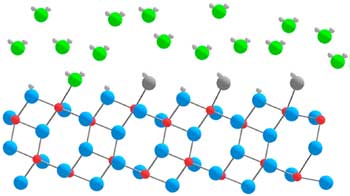| Posted: Jun 20, 2018 |
Photocatalysis: Importance of the aqueous interface
(Nanowerk News) The interaction of water on TiO2 is crucial to elucidate photocatalytic water splitting for hydrogen fuel generation. Anatase and rutile are the most commonly occurring polymorphs of TiO2. Although the interaction of water on rutile surfaces has been extensively probed, similar work on anatase is lacking.
|
|
Led by Prof. Geoff Thornton of the London Centre for Nanotechnology, a multi-institutional team of experimentalists and theoreticians from the UK, Spain, France and USA present a quantitative structural analysis of the interface between natural (reduced) anatase TiO2 (101) (A101) and water. Surface X-ray diffraction results for the room temperature interface with an ultra-thin water film (10±2 monolayers) and bulk water are discussed by reference to density functional theory calculations.
|
 |
| Structure of the interface between natural (reduced) anatase TiO2 (101) and water. (© ACS)
|
|
This study ("Water Dissociates at the Aqueous Interface with Reduced Anatase TiO2 (101)") shows that room temperature aqueous interfaces with reduced A101 have a mixture of molecular H2O (25%) and OHt (75%) bound to Ti5c in the contact layer. OHt formation from water dissociation is accompanied by the formation of OHbr.
|
|
On the basis of previous calculations, the reduced state of the anatase will play a crucial role in the formation of this contact layer since it provides the excess electrons needed for dissociation. Upon water exposure to the as-prepared surface, the surface atoms contract towards the bulk and adopt a relatively more bulk-like appearance when compared to the as-prepared surface.
|
|
This study highlights the importance of the substrate environment in determining its reactivity. For A101, the aqueous interface is reactive, whereas the UHV substrate is inert at room temperature. Since the aqueous interface is relevant in photocatalysis, it also highlights the importance of studies in realistic environments.
|
|
The authors present an atomistic experimental and theoretical perspective of the A101 / H2O interface which will allow for future investigations pertaining to understanding the precise mechanism of photocatalysis on TiO2. Ultimately this will drive future materials design and engineering to optimise the photocatalytic process on TiO2.
|

